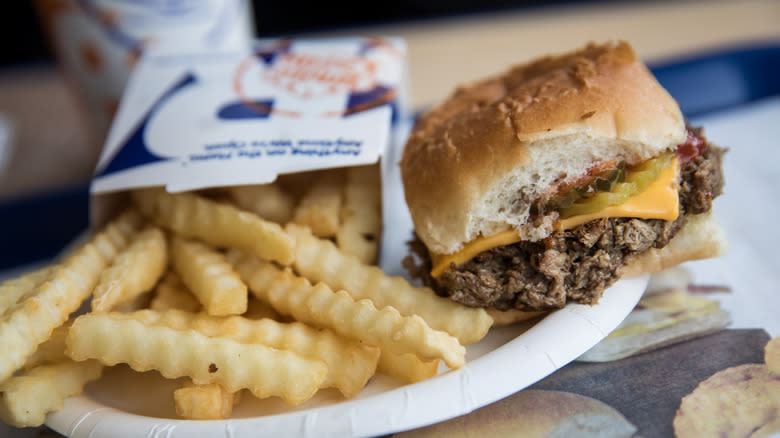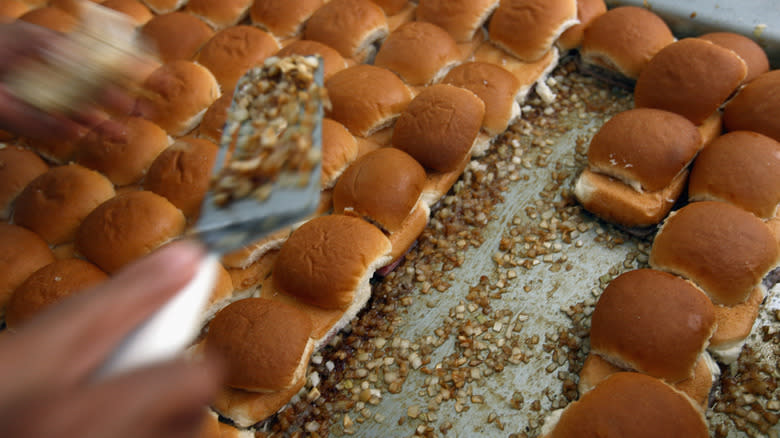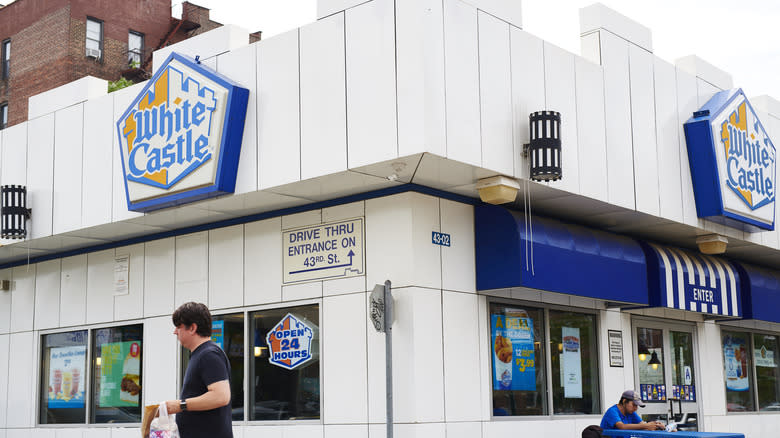The Story Behind How White Castle Got Its Name

- Oops!Something went wrong.Please try again later.
For residents in the Midwest and Northeast, White Castle is the premiere location for burger sliders. What's more, the opening of its Wichita, Kansas restaurant in 1921 laid the foundations of America's fast food industry. Shaped like a medieval castle, many customers likely think that the restaurant drew inspiration from the Middle Ages. After all, it wouldn't look out of place at a Renaissance fair.
However, the actual origin of White Castle's name has a more modern (at least relatively) and domestic point of origin. Co-founders Walt Anderson and Billy Ingram created the name for their restaurant as a counterpoint to Upton Sinclair's exposé "The Jungle." Sinclair's book shone a light on the restaurant and meat industry, illustrating many of the unsanitary practices of the time.
As a result, it created a stigma around ground beef and restaurants, which wasn't ideal for the two co-founders running a burger shack. So, the pair named their business White Castle to signal to customers the purity of their food. White symbolizes purity and is often used in religious and wedding imagery. A castle is a symbol of structural integrity and permanence. Combined, it signaled to customers that its meat and food were safe. Consequently, it is a restaurant that has, in many ways, stood the test of time.
Read more: The Ultimate American Fast Food Restaurants Ranked
White Castle Was Based On A Local Building

The key to White Castle's emergence in the food landscape was its commitment to cleanliness. Walt Anderson and Billy Ingram extended this idea to the design of the restaurants, taking influence from the Old Water Tower in Chicago. The co-founders drew inspiration from the water tower, making modifications to design their restaurants to resemble a small castle. Sticking with the idea of the color white representing cleanliness, they decorated the interior with porcelain, intended to invoke a feeling of the utmost hygiene. It was all part of Ingram's plan to convey to consumers that White Castle was different. Part of the intention was to standardize the experience so that every White Castle operated to the same standard and quality.
White Castle restaurants were impermanent structures built out of porcelain steel and modeled by Porcelain Steel Buildings (PSB) Co. -- a company incorporated by Anderson and Ingram to carry out construction on their restaurant sites.These fabricated buildings made it easy for the company to create multiple restaurants of the same design. Part of that design was an open layout where customers could see chefs working in the kitchen, ensuring a degree of trust with clientele. The company also introduced hygiene practices for employees, requiring all staff to meet cleanliness standards and, to avoid food contamination, wear paper hats -- also patented by the duo who started the Paperlynen Company to make them.
White Castle Fought A Social Stigma

For White Castle, Billy Ingram handled much of the restaurant's promotion. At the time, he faced the stigma that ground beef wasn't healthy and posed significant health risks, a feeling that went beyond Upton Sinclair's book. For instance, according to America Comes Alive!, one critic wrote, "The hamburger habit is just about as safe as walking in a garden while the arsenic spray is being applied, and about as safe as getting your meat out of a garbage can standing in the hot sun." Walt Anderson noticed that some customers ordered from their restaurant in secret, too ashamed to be caught with the sliders.
To convince customers of ground beef and, therefore, White Castle's safety, Ingram got researcher Jesse McClendon to perform an experiment where a person consumed only White Castle burgers and water for 13 weeks. After the experiment, the participant was found to be just fine despite eating 20 to 24 burgers a day. As a result, Ingram had a hook for customers, promoting the study to advertisers and adopting pioneering marketing techniques for the time that are commonplace today. This helped shift the view that ground beef was unsanitary. Moreover, Anderson started ordering fresh beef twice a day and ground it in full view of diners to demonstrate its freshness.
White Castle prevails today thanks to the savvy opportunities pursued by its founders, led by the promotion of hygienic restaurants and sanitary practices as implied in its name.
Read the original article on Daily Meal.

